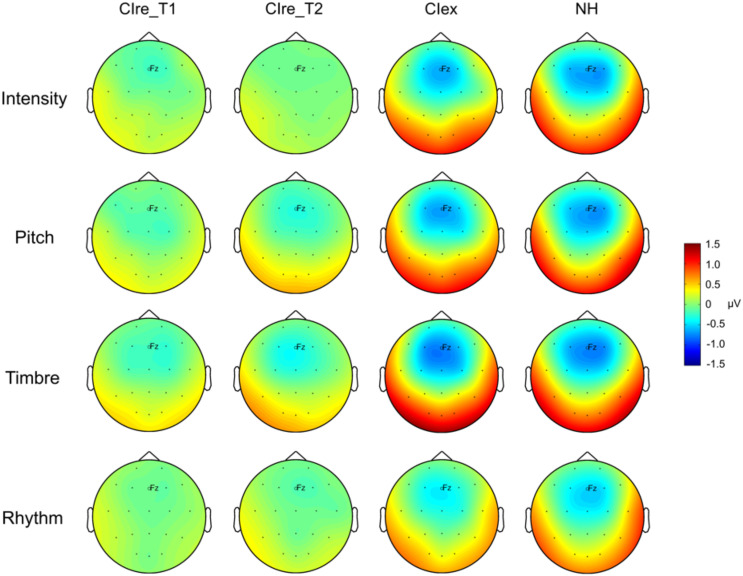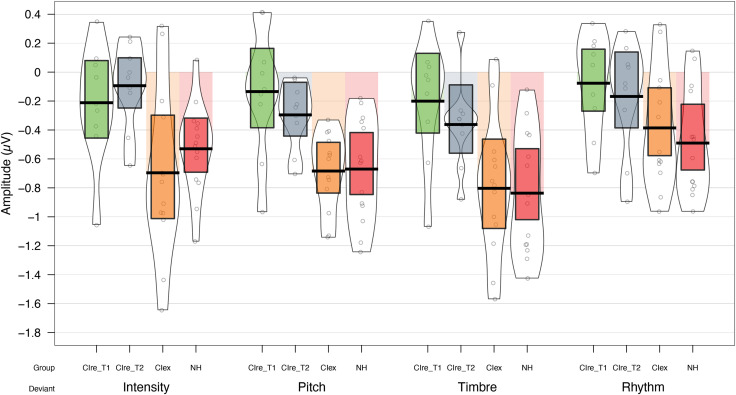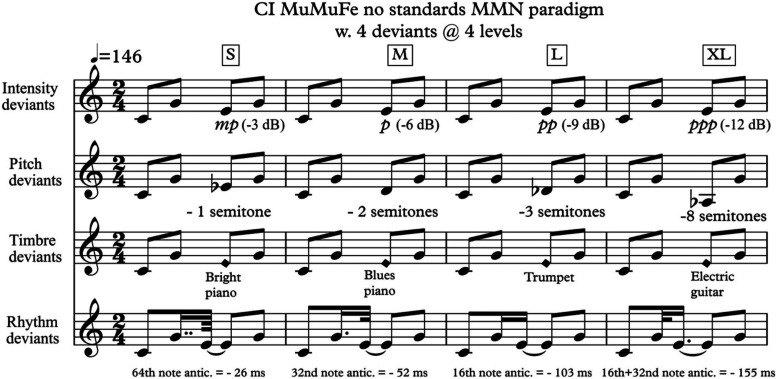Adapting to the Sound of Music - Development of Music Discrimination Skills in Recently Implanted CI Users.
IF 3
2区 医学
Q1 AUDIOLOGY & SPEECH-LANGUAGE PATHOLOGY
引用次数: 2
Abstract
Cochlear implants (CIs) are optimized for speech perception but poor in conveying musical sound features such as pitch, melody, and timbre. Here, we investigated the early development of discrimination of musical sound features after cochlear implantation. Nine recently implanted CI users (CIre) were tested shortly after switch-on (T1) and approximately 3 months later (T2), using a musical multifeature mismatch negativity (MMN) paradigm, presenting four deviant features (intensity, pitch, timbre, and rhythm), and a three-alternative forced-choice behavioral test. For reference, groups of experienced CI users (CIex; n = 13) and normally hearing (NH) controls (n = 14) underwent the same tests once. We found significant improvement in CIre's neural discrimination of pitch and timbre as marked by increased MMN amplitudes. This was not reflected in the behavioral results. Behaviorally, CIre scored well above chance level at both time points for all features except intensity, but significantly below NH controls for all features except rhythm. Both CI groups scored significantly below NH in behavioral pitch discrimination. No significant difference was found in MMN amplitude between CIex and NH. The results indicate that development of musical discrimination can be detected neurophysiologically early after switch-on. However, to fully take advantage of the sparse information from the implant, a prolonged adaptation period may be required. Behavioral discrimination accuracy was notably high already shortly after implant switch-on, although well below that of NH listeners. This study provides new insight into the early development of music-discrimination abilities in CI users and may have clinical and therapeutic relevance.



适应音乐之声——新近植入CI使用者音乐辨别能力的发展。
人工耳蜗(CIs)在语音感知方面进行了优化,但在传递音高、旋律和音色等音乐声音特征方面表现不佳。在此,我们研究了人工耳蜗植入后音乐声音特征辨别的早期发展。9名最近植入的CI用户(ciire)在打开后不久(T1)和大约3个月后(T2)进行了测试,使用音乐多特征失配否定(MMN)范式,呈现4个异常特征(强度、音调、音色和节奏),以及3个选项的强迫选择行为测试。作为参考,有经验的CI用户组(CIex;n = 13)和听力正常(NH)对照组(n = 14)进行了一次相同的测试。我们发现CIre对音高和音色的神经辨别有了显著的改善,这是由MMN振幅的增加所标志的。这并没有反映在行为结果中。在行为学上,CIre在两个时间点的所有特征(强度除外)得分均高于机会水平,但在所有特征(节奏除外)得分均显著低于NH对照组。两个CI组在行为音高辨别上的得分都明显低于NH组。CIex与NH在MMN振幅上无显著差异。结果表明,音乐辨别的发展在开启后的早期就可以从神经生理学上检测到。然而,为了充分利用来自植入物的稀疏信息,可能需要较长的适应期。在植入物打开后不久,行为辨别的准确性就已经非常高了,尽管远低于NH听众。本研究为CI使用者音乐辨别能力的早期发展提供了新的见解,并可能具有临床和治疗意义。
本文章由计算机程序翻译,如有差异,请以英文原文为准。
求助全文
约1分钟内获得全文
求助全文
来源期刊

Trends in Hearing
AUDIOLOGY & SPEECH-LANGUAGE PATHOLOGYOTORH-OTORHINOLARYNGOLOGY
CiteScore
4.50
自引率
11.10%
发文量
44
审稿时长
12 weeks
期刊介绍:
Trends in Hearing is an open access journal completely dedicated to publishing original research and reviews focusing on human hearing, hearing loss, hearing aids, auditory implants, and aural rehabilitation. Under its former name, Trends in Amplification, the journal established itself as a forum for concise explorations of all areas of translational hearing research by leaders in the field. Trends in Hearing has now expanded its focus to include original research articles, with the goal of becoming the premier venue for research related to human hearing and hearing loss.
 求助内容:
求助内容: 应助结果提醒方式:
应助结果提醒方式:


